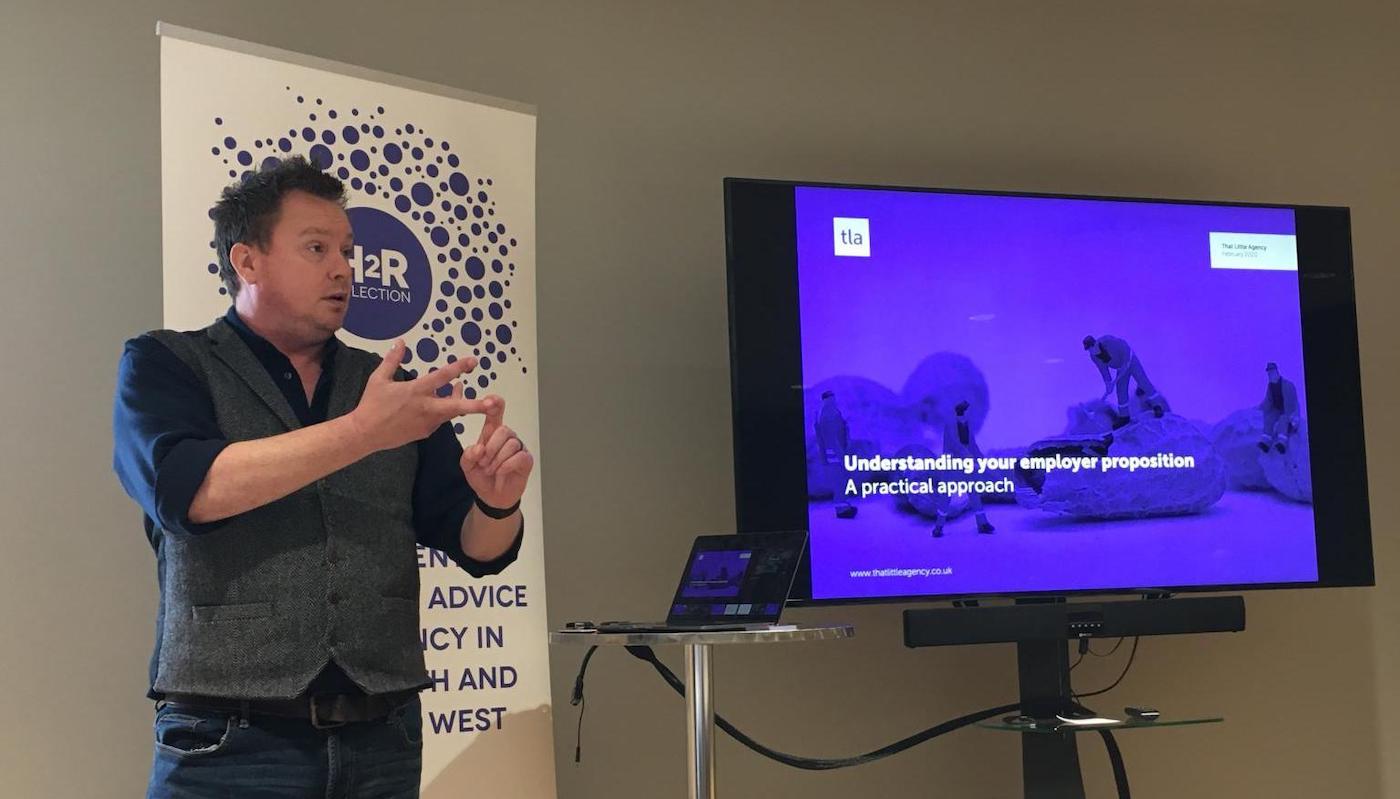On Thursday, 27th February a gathering of Bristol’s HR community met in the shadow of the world’s fastest ever passenger jet, Concorde. Buckled up, we went through a supersonic session around employer proposition and employer branding. I was in the pilot’s seat for this one, as the guest of H2R Selection … OK, that’s enough, I’ve run out of Concorde references. But I will share the main points we covered on the day. Please put your seats into the upright position and prepare for take-off. Sorry.
Employer brand – you already have one
I’ve said this many times before and this talk was the prefect place to make the point again. As an employer, whether you know it or not – and whether you like it or not – you already have an employer brand. In essence this is what your employees and possibly your candidates already think about you. It’s what they might say if you weren’t in the room. And in most instances, they’ll have different views.
So where does employer proposition fit in?
This is the answer to the question ‘why would somebody work here as opposed to somewhere else?’ But, and I am going to prick an industry taboo here, there’s no such thing as a single employer proposition! Mainly because:
- It will differ from one role to another
- It will differ from one department to another
- It will differ from one location to another
- It will differ from one generation to another
- It is certainly different to what your leadership teams thinks it is.
- You can’t create or destroy it.
The good news is that, despite all of this – you can influence it.
And why should you care?
Because more and more of your candidates will be doing their research before making the decision to apply. They’ll be looking on sites like Glassdoor and Indeed – keen to read what others (not you!) are saying about what it’s like to work for you.
They’ll want to know about your culture and values. They’ll look for insight on you and they’ll make their own decisions whether or not you are a good cultural fit.
What’s more, research from LinkedIn found that a strong employer brand could result in a 43% decrease in cost per hire, a 28% decrease in employee turnover – and a 50% decrease in the time to hire. That sounds pretty compelling to me.
So, what are the building blocks of a strong employer proposition?
I’m glad you asked. There are three characteristics at the heart of this:
- It’s authentic – what you are saying is believable and credible
- It’s attractive – what you are offering is what your target audience wants and needs
- It’s distinctive – you message is different from your competition for talent.
But, where do you start?
That Little Agency helps clients understand their employer value proposition (EVP) with a six step process, these are the questions you’ll need to ask yourself. Here is a very brief summary:
Step 1 – Benchmark: Where are we right now? What are our competitors up to? How do we stack up?
Step 2 – Preparation: What do we want to get out of this exercise? What does success look like? Who are we talking to? Your target audiences may well be very different employee categories.
Step 3 – Ask … and listen: What do people want? Do they think we can offer it? Can we really offer what they are looking for? This stage is all about gaining insight.
Step 4 – Distill this insight: You are looking for a set of universal truths, these will be – your employer personality, your employer proposition pillars and, maybe, you’ll get this into a single statement.
Step 5 – Map these against your key employment groups: What messages resonate with which audiences? What should we be saying?
Step 6 – Develop your employer identity: Ask yourself whether you align with you corporate identity or not, launch it internally first, embrace your people, make a statement.
Practical examples
Throughout the presentation I shared examples of two very different EVPs – for retailer Toolstation and the Telegraph Media Group. I am happy to share the slides if you would like to email me directly. mark@thatlittleagency.co.uk
We thought we’d share a few comments from the room
Some of the points made in the wrap up included:
“Salary is becoming far less important to candidates, they are increasingly asking about our values as a company and what we are doing to give something back.”
“You can get a lot right internally with your hiring process – but it all gets let down with a poorly written recruitment advert. There should be less ‘you will do this’ in copy, and more emphasis on ‘what you could achieve’ in the advert.”
“LinkedIn is making a great push into the recruitment market. It’s always been good for sourcing candidates, now it wants to be the job board of choice.”
“It’s well worth getting all the information a candidate might need on the careers website before they find you. You only get one chance to make a good impression so make sure all the content is there.”
“Understanding your employer proposition is continuous project. Build into any work milestones for re-evaluating, re-validating and re-launchin as your business evolves.”
“Understand your target audience and don’t expect all job types to fit into your culture. For example, if you want to recruit developers, don’t expect them to wear suits – you need to compromise or they just won’t join you.”
“The whole recruitment process starts internally with your culture. Get this wrong and successful recruitment will always be a challenge.”
“It’s a good idea to keep in touch with people who have left you at the six month point. Such ‘Boomerang employees’ won’t yet be fully engaged with their new employer, that’s your ideal point to try and re-hire.”
Big thanks to
Richard Freke and Bryonie Madine from H2R Selection for inviting me to speak and to our fantastic audience for their interest and many great contributions.
For further information
If you feel that you’d like some help, support or even a little chat around developing your employer proposition or any aspect of your talent attraction strategy just drop me a line. After all, much of our best work has started with a cup of tea and a biscuit.


